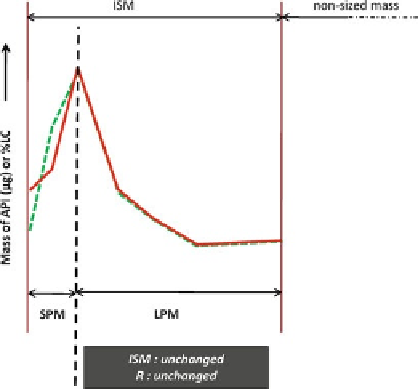Biomedical Engineering Reference
In-Depth Information
Fig. 9.4
Situation 2 for
potential failure of EDA:
change of shape in
SPF
alone
but the same absolute
SPM
before and afterwards (
From
[
3
]
—used with permission
)
9.3.2
Change of Shape in Small Particle Fraction Alone But
the Same Absolute SPM Before and Afterwards
In the second situation considered by Mitchell et al. [
3
] (Fig.
9.4
), the transfer of
mass within the APSD takes place exclusively within the bounds for the
SPF
, essen-
tially making this process complementary to the fi rst situation.
Signifi cant removal of particles to the walls of the CI by Brownian diffusion will
almost certainly be entirely confi ned to the
SPF
. If present at all, this effect is only
likely to be observable on a mass-weighted basis in the extra-fi ne range <0.5
m
aerodynamic diameter. Since all
SPF
particles would be captured by the walls of the
CI or on the backup fi lter regardless of size, it is conceivable that
SPM
might remain
constant, but only if the API deposited on the walls of the CI is recovered, assayed,
and assigned to the appropriate mass fraction.
LPM
would also remain constant by
defi nition in this scenario, so that
ISM
would also be unaffected. However, in reality
this scenario is a highly remote possibility, given the typically short duration of
aerosol transport through the portion of the CI in which the
SPF
collects when the
compendial apparatuses are operated within their recommended fl ow rate range.
Since none of these apparatuses operate at fl ow rates <15 L/min, they are not
low-fl ow impactors, such as the QCM system (California Measurements Inc., Sierra
Madre, CA, USA) that operates at only 0.24 L/min [
6
].
It should be noted that if the MOC is used with the NGI, it is not a perfect fi lter,
and so any signifi cant changes in the penetration of this stage brought about through
Brownian diffusion would likely be detected as variations in the
LPM
/
SPM
ratio.
APSD changes due to Brownian diffusion are likely only to affect the tail at the
fi ne end of the APSD (<1.0
μ
m aerodynamic diameter), so that they are most prob-
ably only a consideration with solution pMDI products, considering the entire range
of currently marketed OIPs. Even if EDA were to fail to detect a scenario 2 shift in
μ

Search WWH ::

Custom Search